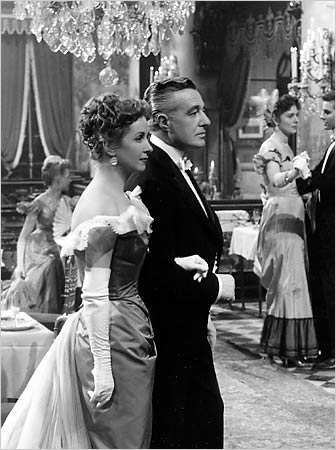The Earrings of Madame de...
A film by Max Ophuls
Starring Vittorio De Sica
A film by Max Ophuls
Starring Vittorio De Sica
1953/ France – Italy/ 105 minutes
5.45 pm at Perks Mini Theater
http://konangalfilmsociety.blogspot.in
5.45 pm at Perks Mini Theater
http://konangalfilmsociety.blogspot.in
“The Earrings of Madame de...,” directed in 1953 by Max
Ophuls , is one of the most mannered and contrived love movies ever filmed. It
glitters and dazzles, and beneath the artifice it creates a heart, and breaks
it. The film is famous for its elaborate camera movements, its graceful style,
its sets, its costumes and of course its jewelry. It stars Danielle Darrieux ,
Charles Boyer and Vittorio De Sica , who effortlessly embody elegance. The
story takes place in Vienna a century or so ago. The General (Boyer) has
married late, and well, to Louisa (Darrieux), a great beauty. He gives her
expensive diamond earrings as a wedding present. She sells them to meet her
debts. Then fate takes over. She meets
the handsome Baron. Their tragedy is that the intensity of her love carries her
outside the rules, while the Baron remains safely in-bounds.In this charming
film, the travels of a the pair of heart-shaped diamond earrings of Louisa
impel the plot.
Louisa and her husband live in a society where love
affairs are more or less expected; “your suitors get on my nerves,” the General
fusses as they leave a party. If they do not know specifically who their spouse
is flirting with, they know generally. But there is a code in such affairs, and
the code permits sex, but not love. “Our marriage is only superficially
superficial,” says Monsieur de, played by Charles Boyer (in his first French
film since before the war), as he gingerly approaches the subject of her new
lover with his flighty, distracted wife. For Louisa, the earrings teach a
lesson. She is no more morally to blame than her husband or her lover, if only
adultery is at stake. But if the General's honor is the question--if being
gossiped about by the silly admiral's wife is the result--then she is to blame.
In the end nothing remains of Madame de except for the
pair of earrings — diamonds cut in the shape of a heart — which she leaves
behind as an offering in a dank neighborhood church. But as Ophüls’s camera
closes in on them, moving across the empty church to the glass case that
contains them, marked with a silver plaque with her name, we see the diamonds
have become her: glittering, transparent, icily beautiful, they are now
illuminated by a flickering candle, a trembling spirit that nothing can erase.
This ending, one of the most beautiful in the movies, contains the essence of
Ophüls’s art.
(Source: Internet)
Max Ophuls (1902-1957)
Max Ophuls (1902-1957) was a German who made films in Germany,
Hollywood and France. His career was used by the critic Andrew Sarris as a
foundation-stone of his auteur theory. Sarris famously advised moviegoers to
value thehowof a movie more than thewhat. The story and
message are not as important, he said, as the style and art. In Ophuls, he had
a good test case, because Ophuls is seemingly the director most obsessed with
surfaces, with the visual look, with elaborate camera movements. He was
dismissed by many as nothing more than a fancy stylist, and it took Sarris (and
the French auteurists) to show what a master he was.
His films are one of the great pleasures of the cinema.
"Madame de..." is equaled by “La Ronde” (1950) and "Lola
Montes" (1955) as movies whose surfaces are a voluptuous pleasure
to watch, regardless of whether you choose to plunge into their depths. The
long, impossibly complex opening shot of “La Ronde,” with the narrator
introducing us to the story and even singing a little song, is one of the
treasures of the movies. And who else has such romantic boldness that he will
show Louisa writing her Baron day after day, with no letter back, and then have
him tell her when they finally meet: “I always answered your letters, my
love--but I lacked the courage to mail them.” And then to show his unmailed
letters torn into bits and flung into the air to become snow.




